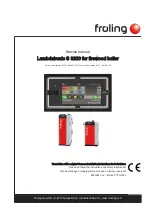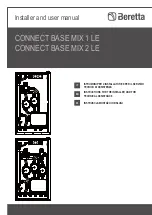
vii)
Turn on the electrical supply to the boiler (gas still off), wait for the fan to
reach full speed.
viii)
The pressure difference should be below 17 mbar. If not, clean heat
exchanger.
ix)
Disconnect the gauge from point B. Refit the screw.
x)
Read pressure of point C.
xi)
The maximum pressure should be 3.5 mbar. If the pressure is greater
than this, check the flue for blockage.
xii)
Turn off the electrical supply to the boiler.
xiii)
Remove the pressure gauge tube and refit the screw.
xiv)
Open the gas service cock.
6.2
Recommended Routine Service
a.
Inspect the air filter located at the top right hand side of the boiler. Release the
toggle catch on the filter tray and remove the filter.
If the filter looks dirty remove the dirt with a vacuum cleaner or by other means. If
in any doubt renew the filter element.
b.
Remove the burner head (Section 7.7) and inspect the burner appearance. Black
markings or other discolourations on the gauze indicate too much gas or a lack of
air possibly due to a blocked air filter. Any breakages or damage to the burner
mesh indicate the burner must be replaced.
c.
If necessary, either due to discolouration or a high pressure differential between
points A & B in the pre-service checks, clean the burner with a mild household
detergent and rinse under a hot running tap.
WD51/2/1997 Chapter 6 : Servicing
The Keston 170 Condensing Boilers
Installation & Servicing Instructions
Page : 39
Pressure Test
Point B
Pressure Test
Point A
Burner Heat (From Above)
Pressure Test
Point C
Combustion
Test Point
Flue Overheat
Thermostat
Heat
Exchanger
Shell
Flue
Fig 6.1.1 Pressure Test Point Locations
&













































